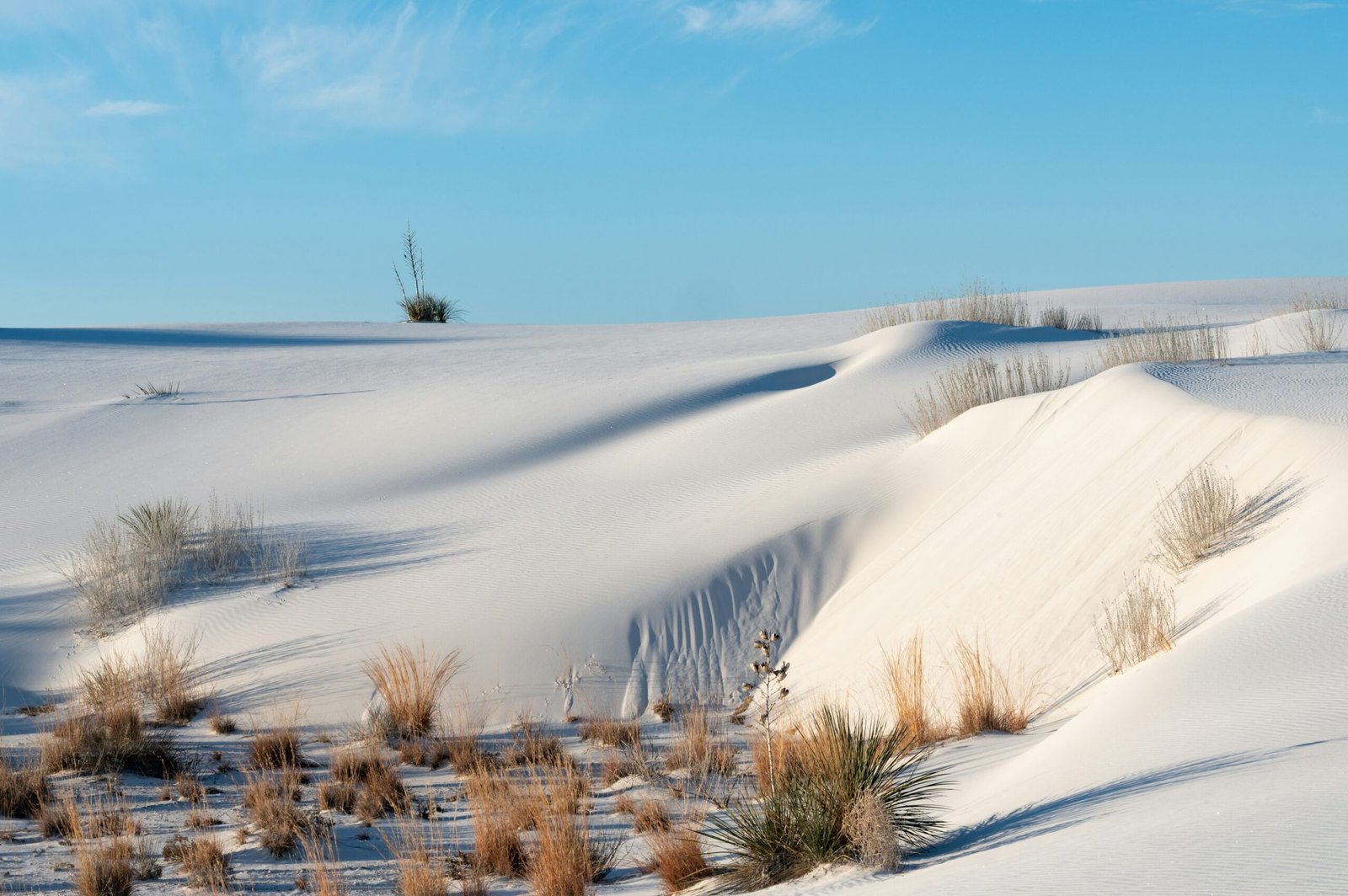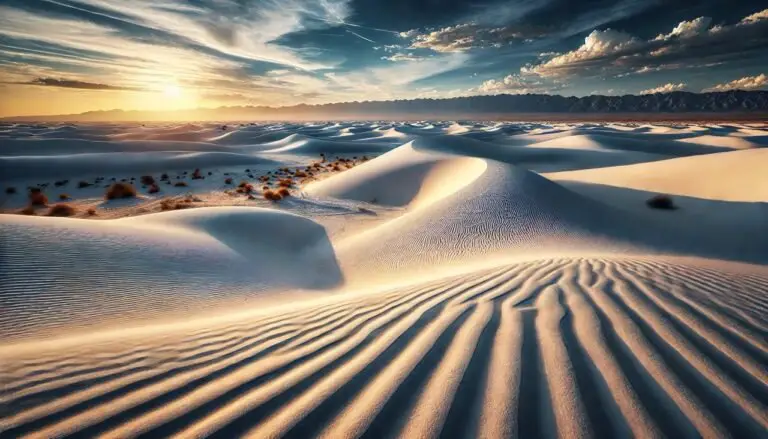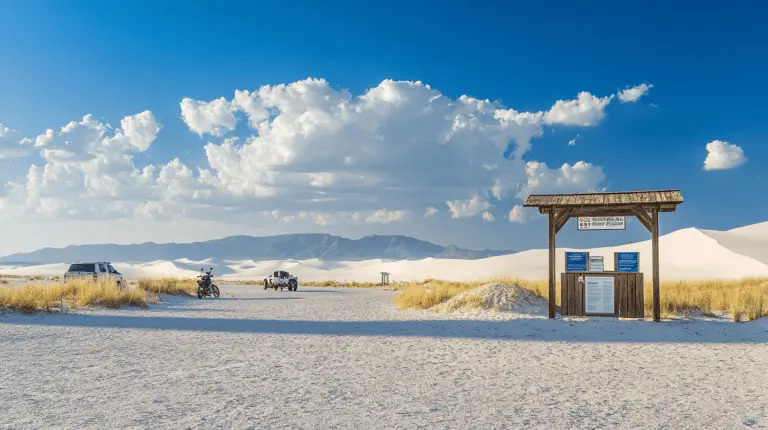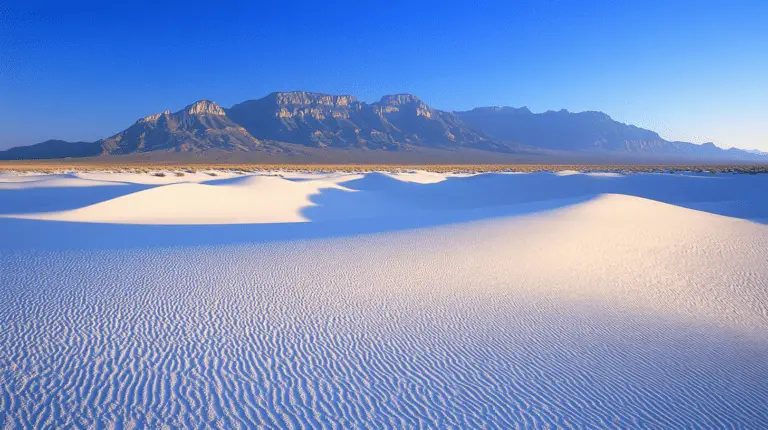Discover the Wonders of White Sands New Mexico
White Sands National Park, situated in southern New Mexico, boasts a diverse history stretching back over 10,000 years. Early peoples arrived here searching for food, water, and shelter. Over time, Spanish explorers, miners, and ranchers left their marks on this unique area. Fast forward to World War II, and the basin became significant for U.S. military scientific research following the bombing of Pearl Harbor.
In 1933, President Herbert Hoover declared it a National Monument, spanning 142,987 acres. This designation aimed to recognize its scientific, scenic, and educational value. Then, on December 20, 2019, it was upgraded to White Sands National Park, becoming the 62nd national park in the U.S., under legislation signed by President Donald Trump.
Stunning Geology of White Sands
The park isn’t just any sandpit; it’s home to the world’s largest gypsum dune field, covering 275 square miles. Gypsum is not your usual sandy suspect since it’s typically water-soluble. But in the Tularosa Basin—a place with no rivers to drain water—gypsum stays put, creating these impressive dunes as water evaporates.
Think about it: these dunes started forming between 7,000 to 10,000 years ago. Wind and water continuously grind gypsum crystals into sand-sized particles. Then, strong southwest winds swoop in to sculpt the mesmerizing dunes we see today.
| Feature | Detail |
|---|---|
| Gypsum Dune Field | 275 square miles |
| Formation Timeline | 7,000 – 10,000 years ago |
| Climate Effect | Tularosa Basin has no river outlets |
| Geological Claim | Largest gypsum dune field globally |
For deeper insights into these geological wonders, check out our White Sands Geology Guide.
White Sands National Park also rubs shoulders with the White Sands Missile Range, the largest military installation in the U.S., covering 3,200 square miles. Worth noting: this is the site where the first atomic bomb test went off in 1945. So, not just a pretty face—White Sands packs serious historical punch.
Wondering what to do when you visit? Browse our Activities at White Sands or find detailed Visitor Information for your trip. Flora, fauna, and endless adventure await in this one-of-a-kind park!
Visitor Information
Park Size and Features
Welcome to White Sands National Park! This stunning place covers a massive 275 square miles and flaunts the planet’s biggest gypsum dune field. Imagine miles and miles of gleaming white sands that sparkle under the sun, making the heat feel just a bit less intense. These shifting dunes, created from gypsum deposits in the San Andres Mountains, are the park’s pride and joy (Visit Las Cruces).
| Feature | Description |
|---|---|
| Total Area | 275 square miles |
| Main Attraction | World’s largest gypsum dune field |
| Temperature Range | 60ºF (16ºC) in winter to 95ºF (35ºC) in summer |
Want to nerd out on park geology? Check out our guide on white sands national park geology.
Visitor Center and Museum
The White Sands Visitor Center is the perfect spot to start your adventure. Packed with maps, brochures, and schedules for guided tours, you’ll find everything you need here. Plus, there’s a museum that’s great for soaking up info on how these dazzling dunes came to be, along with the park’s unique plants and critters.
| Facility | Information |
|---|---|
| Visitor Center | Offers maps, brochures, guided tour schedules |
| Museum | Exhibits on geology, ecology, history |
| Location | Near the park entrance |
For hours and more deets, pop over to white sands national park visitor center.
Entrance Fees and Visitor Passes
Get ready to soak in the beauty because a visit to White Sands National Park does come with a price. Fees are based on what kind of ride you’re bringing along. And if you’re a park-hopper, the annual pass could save you some serious cash.
| Type of Admission | Fee |
|---|---|
| Per Vehicle | $25 |
| Per Motorcycle | $20 |
| Annual Pass (America The Beautiful) | $80 |
These fees help keep the park in tip-top shape. If you’re a frequent national park visitor, definitely consider the America The Beautiful pass (Across The World Together). Want to know more? Head to our page on white sands national park entrance fee.
Escape the ordinary and dive into the magic of White Sands National Park. Plan ahead, use the resources, and make your visit unforgettable. For more in-depth tips, check out our full white sands national park guide.
Activities at White Sands
White Sands National Park is your playground of dazzling white gypsum dunes, perfect for activities that’ll make your visit unforgettable. Here’s the scoop on what you can dive into at this one-of-a-kind spot.
Hiking Trails
Ready to stretch those legs? The hiking trails at White Sands let you wander through stunning dunes and take in the sights. Here’s the lowdown:
- Interdune Boardwalk: A breezy 0.4-mile stroll with educational displays about the local environment.
- Dune Life Nature Trail: A medium 1-mile loop giving you a peek into desert life.
- Alkali Flat Trail: A tough but rewarding 5-mile trek right into the heart of the dunes (Visit Las Cruces).
Keep an eye on the weather at White Sands before you head out, since it can swing from sunshine to sizzling.
Sand Dune Sledding
Who says sledding is just for snow? Sand dune sledding is a must-try at White Sands. Sleds are up for grabs at the visitor center. Here’s how to nail it:
- Use those round, wax-coated sleds for a smooth glide down the dunes.
- Skip the flips to keep everything in one piece.
- Always keep an eye on kids—better safe than sorry.
- Keep your bum on the sled; don’t go headfirst (Across The World Together).
Need more inspo? Check out our tips for fun activities at the park.
Guided Tours and Programs
Want the full scoop? Join a guided tour at White Sands and get the 411 from Park Rangers. They know the place inside out and offer tours like:
- Moonlight Hikes: Experience the magic of the dunes under a blanket of stars.
- Sunset Tours: Catch the sun doing its thing over the glittering dunes.
- Educational Programs: Perfect for the kiddos—or the kid in you.
These tours add value to your visit and help support the park’s educational efforts.
So gear up for a trip you’ll be talking about for years. Don’t forget to check for park alerts—sometimes missile tests at the nearby White Sands Missile Range can throw a wrench in your plans.
Flora and Critters
Welcome to White Sands National Park! Nestled in New Mexico, this place is a gem for anyone eager to check out some crazy cool plants and animals that have totally nailed surviving in a tough spot.
Plants Toughing It Out
The sea of gypsum dunes at White Sands isn’t just sand and wind. It’s alive with plants that laugh in the face of harsh conditions. Here’s a peek at the gang you’ll find hustling in the dunes:
- Cacti: Tough cookies that stash water in their chunky stems.
- Succulents: Like agave, sipping on minimal water and still thriving.
- Grasses: Found the likes of alkali sacaton here.
- Desert Shrubs: Old-timers like creosote bush and yucca holding their ground.
If you’re craving more green deets, dive into our plants page for the nitty-gritty.
Animal Cast Members
This park isn’t just about the plants. It’s a bustling metropolis for wildlife—a drama with over 600 invertebrates, 250 birds, 50 mammals, and 30 reptiles (Source).
| Type | Cool Residents |
|---|---|
| Carnivores | Coyotes, Bobcats, Badgers, Kit Foxes |
| Herbivores | Rabbits, Rodents |
| Birds | Greater roadrunner, Western meadowlark |
| Reptiles | Lizards, Snakes |
| Amphibians | Frogs of many flavors |
Want a deeper dive into the critter scene? Hit up our animals page.
The Rare and Odd Ones Out
White Sands is a VIP club for around 45 endemic species, with 40 of those being moths (Source). Oh, and let’s not forget the roughly 3,000 African Oryx strutting around—these antelope superstars were parachuted in between ’69 and ’77, and they’ve made themselves right at home (Source).
For the full scoop on these park celebs, our rare species page has your back.
Curious about the gritty details of the sands themselves? Our geology page will scratch that itch.
Come explore the weird and wonderful by yourself—because nothing beats seeing it with your own eyes!
Best Times to Visit White Sands National Park
Planning your trip to White Sands National Park right is vital to squeeze the most out of your adventure. Knowing when to go, what the weather looks like, and if the park might be off-limits will make your visit smooth sailing.
Best Seasons
Aim to visit in spring, fall, or winter when things are comfy. These times serve up pleasant temperatures, perfect for wandering those mesmerizing white sand dunes and enjoying other fun stuff.
| Season | Avg High (°F) | Avg Low (°F) |
|---|---|---|
| Spring (Mar-May) | 75° – 85° | 45° – 55° |
| Fall (Sep-Nov) | 75° – 85° | 45° – 55° |
| Winter (Dec-Feb) | 60° – 70° | 30° – 40° |
Summers can be brutal, with the mercury hitting 110°F. Not the best time for outdoor shenanigans. If summer it is, go early morning when it’s still bearable (Across The World Together).
Weather Prep
Weather at White Sands changes a lot. Winters are mild with temps between 60ºF and 70ºF, while summer peaks at scorching 110ºF. It’s usually dry, but watch out for sudden windstorms that could mess with your dune exploration.
Gear up with sunblock, a hat, shades, and plenty of water. Check the forecast before you head out.
Park Closure Notices
Sometimes, the park shuts down for missile tests by the nearby White Sands Missile Range (Across The World Together). These usually get announced ahead of time. Always check for closure notices or check the NPS website so you’re not caught off guard.
Staying updated on park conditions ensures your trip goes off without a hitch. For the latest on hours and closures, visit park hours.
Crazy Cool Tidbits About White Sands
White Sands National Park in New Mexico isn’t just another stop on your road trip – it’s a jaw-dropping place teeming with surprises. Here are some fun facts that’ll make your visit even more awesome.
Gypsum Dunes Galore
These aren’t your everyday, run-of-the-mill sand dunes. The white dunes here are made of gypsum crystals. Unlike regular sand, gypsum doesn’t soak up the sun’s heat, so you can walk on it without feeling like you’re in a fire walk. Plus, this funky mineral gives the dunes that crisp white look, setting the stage for some killer White Sands National Park photography.
From Monument to National Park
President Herbert Hoover kicked things off in 1933, creating White Sands National Monument to protect its scenic and scientific wonders (Visit Las Cruces). Fast forward to December 20, 2019, and President Trump upgraded it to White Sands National Park, the 62nd of its kind in the U.S. Now, around 600,000 folks visit every year, making it a must-see hotspot in New Mexico’s National Park System (NPS).
The African Oryx Oddity
Here’s a twist you didn’t see coming: the park boasts a bunch of African oryx. These antelope were introduced in the ’60s and ’70s for hunting but stuck around and made themselves at home. Now, these majestic creatures roam freely, adding a dash of the unexpected to your visit. Want to dig into more about the local wildlife? Check out White Sands National Park animals.
Wrap-Up Your Visit With Fun Knowledge
Now you’re all set to appreciate the quirks and history of White Sands NP. Whether hiking up the dunes, snapping photos, or simply soaking in the surreal views, White Sands serves up a slice of nature like nowhere else. Don’t just take our word for it – go see it for yourself!








